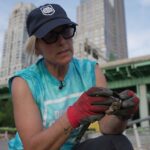Lucio Vasquez / Houston Public Media
Last week, Whitmire said he was concerned about how little space there was at hospitals after the storm, especially since it left at its peak more than 2.2 million CenterPoint customers without power during the scorching summer heat. That number has since reduced to 251,000 as of Monday morning according to the energy company’s online tracker.
Additionally, Whitmire said they were shocked to learn that Houston police officer, Fernando Garcia, who was shot in the leg while working Monday evening, was being treated in a hospital’s hallway. There wasn’t a room for him.
The hurricane impacted 29 hospitals throughout the region, of which 19 are Houston proper hospitals, Tom Munoz, acting director of Houston’s Office of Emergency Management, said to city council last week. To compare, the May derecho affected operations at just a handful of hospitals.
“There are emergency departments that have never had as many people in them before as they have had this week,” said Dr. David Persse, chief medical officer for the City of Houston, said on Friday.
Persse said hospitals were full because of multiple reasons, one being that they weren’t able to discharge patients after the storm. Many patients recovering from surgeries or injuries didn’t have power at home, he said, making it a dangerous place for them to recover.
RELATED: Houston’s NRG Arena serving as medical shelter to assist discharged patients without power at home
“They need wound care, they’re gonna have to have dressing changes,” Persse said of patients who had extended stays at hospitals. “You really don’t want them in some place where they’re gonna be sweating 24 hours a day. You don’t want them someplace where they are going to be hot, getting dehydrated, because their body needs to heal.”
And while patients stayed at hospitals longer, he said more people were going to emergency rooms for reasons beyond medical treatment. With millions of CenterPoint customers without lights or AC the day of the storm, residents who needed to plug in life-saving medical devices were seeking power at hospitals, Persse said.
“A lot of folks have sought shelter at hospitals, a lot of people who have machines that all they really need is a place to plug in,” he said.
Persse and Whitmire share the concern that many cooling centers across the city didn’t have working AC — most multi-service centers didn’t have power or a generator after Beryl. “It’s not going to do any good to say it’s a cooling system and there’s nothing cool there,” said Council Member Carolyn Evans-Shabazz.
“People should not go to hospitals for shelter,” Persse said. “They should not go to hospitals just to get power. They should not go to hospitals just because there’s air conditioning.”
But because of the circumstances of the hurricane, he said he doesn’t “criticize the people who went to the hospital seeking power and shelter, because it was at that point that there were very few options for them to do.”
Persse said hospitals were also tasked with taking in their regular load of patients visiting emergency rooms for medical emergencies.
“Some people who are really sick got admitted to hospitals, just like they would have anyways, but now their whole families are trying to stay with them,” Persse said, “because the home doesn’t have any power, but the hospital does.”
The availability of ambulances was also severely impacted by the overcrowding at hospitals.
Whitmire said the day after the hurricane, only 4% of ambulances were available for calls because they were “backed up at some of our hospitals” for operations scheduled days before the storm.
Persse explained that ambulances weren’t able to drop off patients because there wasn’t space in hospitals to receive them. Many had to hold onto patients for hours.
“The waiting room chairs were full, the stretches were all full, the rooms were all full,” Persse said, later adding that some ambulances waited three hours to offload.










